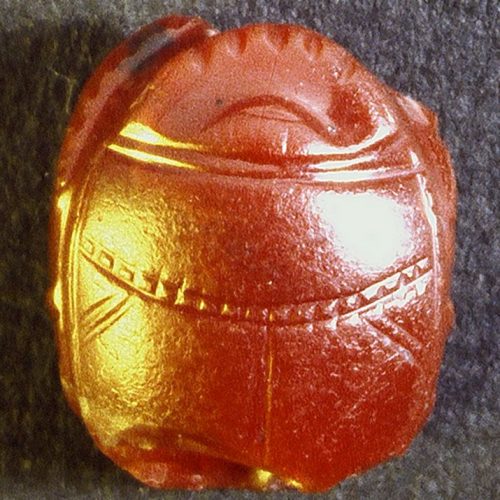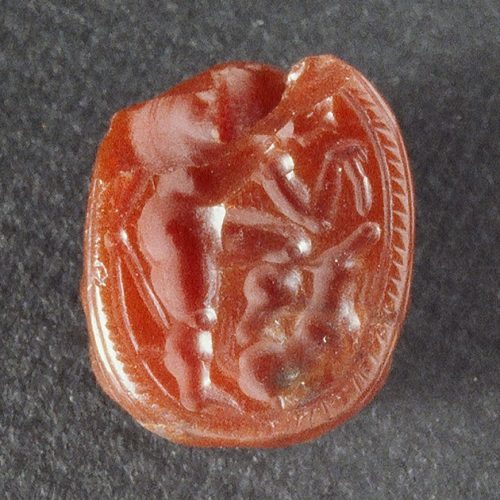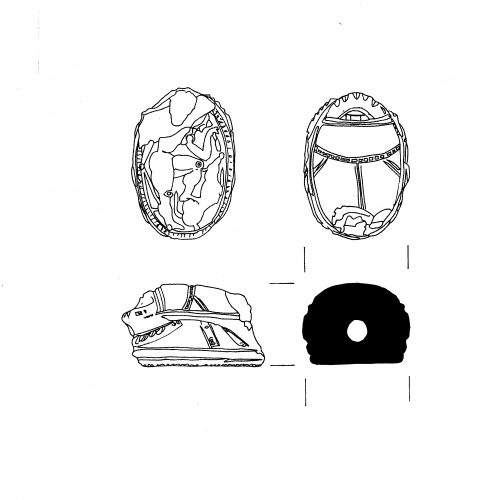
Etruscan Cetamura
Gemstone with Scarab
Period | Etruscan |
Year | Late 4th – early 3rd c. BCE |
Material | Cornelian |
Location | Structure H |
Cet. Inventory | Inv. C-93-71 |
This cornelian gemstone, carved in intaglio with the image of a hero baiting a dog, is a unique object at Cetamura. It seems to be imported, not locally made. The upper side of it is in the popular shape of a scarab beetle.
Prov. 78.5N/2W. 10.1. Structure H. H. 0.8. Dimensions of oval 1.5. x 1.25. Wt. 2g.
Pres. location: Museo Archeologico del Chianti Senese, Castellina in Chianti
Gem carved in the Etrusco-ltalic a globolo style made of hard, red-orange cornelian. Oval shaped, chipped on both sides on opposite ends of oval, part of design missing on both sides. Condition otherwise good. Pierced with hole on long axis of oval; when found, tiny portion of bronze filament was still inside of hole. Upper side rounded, carved in relief with beetle design. Head, prothorax, and wings (elytra) indicated, as well as smaller winglets. Elytra chipped. The underside features an intaglio carving of a powerful nude male figure, turned to the right. Most of the head is missing; perhaps a part of the beard preserved. He bends forward toward an animal, placing his left foot on the creature’s back, and with his left hand dangles above its head something evidently used as a lure. Behind his back he holds in his right hand a weapon or perhaps a snare with which to bind or leash the creature. An oval border with a cable pattern frames the scene.
The intaglio representation is best interpreted as the rare theme of Hercle (the Greek Herakles) attempting to capture a dog through baiting it. The dog is probably the famed hound of the underworld, Kerberos, who is normally represented with three heads, but may have two or only one, as here. The recent monograph study of the Etrusco-ltalic a globolo gems by Ulf Hansson provides abundant evidence that these objects should be dated to the late fourth or third century BCE. The Cetamura gem is stylistically consistent with this dating. It was found, however, in a locus in which the latest datable material was internal red-slip pottery probably of the second century BCE. The find spot was within Structure H on Zone II, located beside the artisans’ area of Cetamura, and perhaps actually part of it; excavation in the area has been limited and the purpose of Structure H is not yet known, but it is interesting that the deposit of the stone is of the same period as the sanctuary of Building L.
A gemstone in similar style has been found at the Hellenistic site of Poggio La Croce, located ca. 10 km. from Cetamura (inv. no. 473-1126, personal communication by the excavator, Marzio Cresci; now in the Museo Archeologico del Chianti, Castellina in Chianti); another, found at Castiglion Fiorentino near Arezzo and dated by Zamarchi Grassi to the 4th century BCE, features a beetle design similar to the one from Cetamura. On the intaglio side (chipped on one end like the Cetamura stone) it displays the theme of Hercle sailing on a raft. The Castiglion Fiorentino gem comes from a sanctuary context and on the whole presents significant and interesting parallels with the Cetamura example.
Date: Late 4th-3rd c. BCE by style.
Bibl. S. Schwartz,” Herakles/Hercle”, Lexicon lconographicum Mythologiae Classicae, 5.1 (1990), 225 (nos. 251 and 253). P. Zamarchi Grassi, Castiglion Fiorentino, un nuovo centro etrusco, Cortona, 1995, 22, figs. 3-4. U. Hansson, A Globolo Gems, Late Etruscan-Italic Scarab Intaglios, Göteborg, 2005, 45, pl.7.30.






